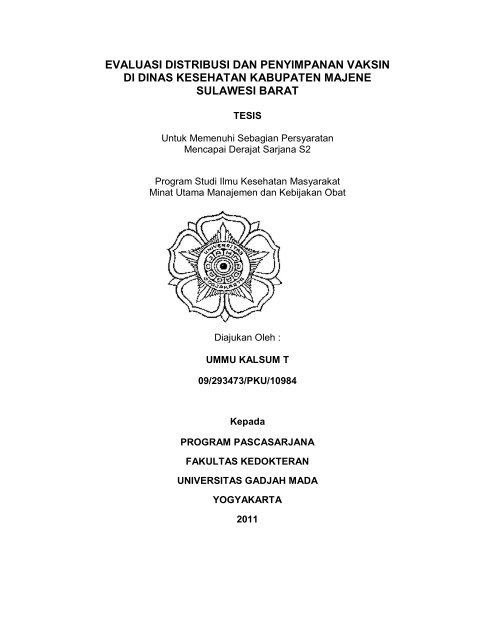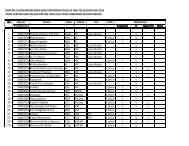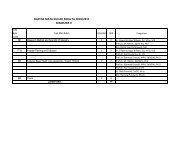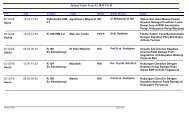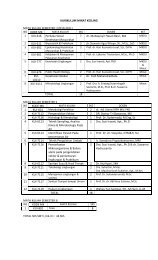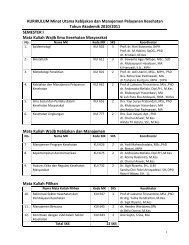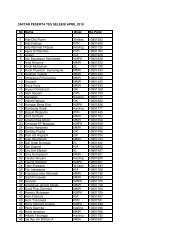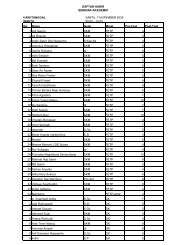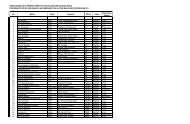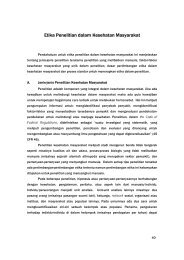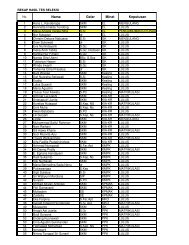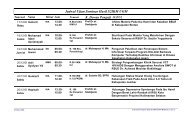evaluasi distribusi dan penyimpanan vaksin di dinas kesehatan ...
evaluasi distribusi dan penyimpanan vaksin di dinas kesehatan ...
evaluasi distribusi dan penyimpanan vaksin di dinas kesehatan ...
You also want an ePaper? Increase the reach of your titles
YUMPU automatically turns print PDFs into web optimized ePapers that Google loves.
EVALUASI DISTRIBUSI DAN PENYIMPANAN VAKSIN<br />
DI DINAS KESEHATAN KABUPATEN MAJENE<br />
SULAWESI BARAT<br />
TESIS<br />
Untuk Memenuhi Sebagian Persyaratan<br />
Mencapai Derajat Sarjana S2<br />
Program Stu<strong>di</strong> Ilmu Kesehatan Masyarakat<br />
Minat Utama Manajemen <strong>dan</strong> Kebijakan Obat<br />
Diajukan Oleh :<br />
UMMU KALSUM T<br />
09/293473/PKU/10984<br />
Kepada<br />
PROGRAM PASCASARJANA<br />
FAKULTAS KEDOKTERAN<br />
UNIVERSITAS GADJAH MADA<br />
YOGYAKARTA<br />
2011
SUMMARY<br />
INTRODUCTION<br />
Effectiveness of Immunization has been proven, globally, nationally and locally.<br />
Immunization program objectives can be achieved with a variety of operational<br />
strategies in the field, among others, through increased knowledge of human resources<br />
through training, provision of infrastructure and logistics chain to target the vaccine to<br />
reduce morbi<strong>di</strong>ty and mortality from <strong>di</strong>seases preventable by immunization.<br />
full immunization in Indonesia, still relatively low at 46.2%. This shows the efforts of<br />
<strong>di</strong>sease prevention has not received a serious attention. Provinces with the worst full<br />
immunization coverage was 13.0% of West Sulawesi in 2007 (Aminullah, 2009). The<br />
lowest coverage contained in the District of Majene (6.7%).<br />
Vaccines used for immunization. The vaccine is a pharmaceutical supplies a<br />
<strong>di</strong>fferent treatment with drugs or other pharmaceutical supplies. Vaccines require<br />
special treatment compared with the others. This is because the vaccine can be easily<br />
damaged if not stored in the refrigerator to maintain temperature stability.<br />
Currently officers have all noticed the composition of the storage of vaccines, health<br />
center officials there who have not made special note of the vaccine storage<br />
refrigerator, in making a vaccine for immunization services are not yet available<br />
thermometer at <strong>di</strong>strict health office. The officer relied only in immunization VVM when<br />
shooting vaccine, it is caused by jurim knowledge is still limited in terms of <strong>di</strong>stribution.<br />
This has become one of the causes of the health center in Ulumanda Kab.<br />
Majene can not run the immunization for 5 months , it is because the vaccine at the<br />
health centers had been damaged. The vaccine has been placed in refrigeration (cold<br />
chain) but the errors start from the <strong>di</strong>stribution to storage process, resulting in the<br />
con<strong>di</strong>tion becomes unstable and is no longer fit for use. Based on data in 2010,<br />
approximately 397 flacon vaccines was reported damaged and 105 flacon were<br />
reported expired so it can not be used anymore. Thus, it is necessary for re-evaluation<br />
the <strong>di</strong>stribution and storage of vaccines for the immunization program implementation in<br />
Majene <strong>di</strong>stric and to all health centers in the District of Majene. Because, in Majene’s<br />
District Health Office have never done an evaluation of <strong>di</strong>stribution and storage of
vaccines, both by health personnel in the health office, health personnel in<br />
healthcenters or by other parties.<br />
METHODS<br />
This study is a descriptive qualitative and quantitative research, with a design<br />
case study. Data collected in the form of quantitative data through observation of<br />
documents in <strong>di</strong>strict health offices and health centers as well as qualitative data in the<br />
form of in-depth interviews. The research was conducted in Majene’s District. Include at<br />
Majene’s Health Office and 8 health centers in the District which are Banggae health<br />
center I, Banggae health center II, health center Pamboang, health center Sen<strong>dan</strong>a I,<br />
Tammero'do health center, health center Sen<strong>dan</strong>a II, health centers Malunda and health<br />
centers Ulumanda. Subjects of the research were Majene’s Chief District Me<strong>di</strong>cal<br />
Officer, Head of Prevention and Era<strong>di</strong>cation of Disease, Section Chief of Investigations<br />
and Disease Prevention, Wasor (Deputy Supervisor) of immunization, head of the clinic<br />
at all health centers and immunization staff in all health centers.<br />
RESULTS AND DISCUSSIONS<br />
1. Immunization Policy<br />
Minister of RI Health Decree No. 1611/Menkes/SK/XI/2005 District <strong>di</strong>d not follow<br />
up with written policies, but only in the form of an agreement between the <strong>di</strong>strict health<br />
office with health centers. Vaccine storage policy from <strong>di</strong>stric health office was to<br />
support concerning the room / storage of vaccines. Storage of vaccines in the <strong>di</strong>strict<br />
health office does not carry a single gate system at the Installation of Pharmacy District<br />
(IFK), but stored in the warehouse section of the P2P program under the authority of the<br />
<strong>di</strong>strict health office. Public Drug Policy Based Management, Drug Program and<br />
Supplies Health Ministry of Health, stated that public drug management, drug programs,<br />
and me<strong>di</strong>cal supplies carried by a single system gates (Gate One Policy) at IFK.<br />
Storage of vaccines in the clinic was placed in a special room with a room separate<br />
immunization program to another.<br />
Immunization programs in Majene’s policy include the achievement of UCI policy<br />
that is a complete basic immunization coverage of at least 80% of infants in 100% rural /
urban villages in 2010. These activities are to socializing immunization programs by a<br />
cadre of immunization programs to the community. Policy pursued in the form of<br />
accelerated achievement of UCI by health office of West Sulawesi province, involving all<br />
the <strong>di</strong>strict health offices in West Sulawesi.<br />
2. Human Resources (HR) Implementing Immunization<br />
Human resources Implementing Immunization in Majene’s Health office <strong>di</strong>stric<br />
comprising 1) Head of Division (Head) Prevention and Era<strong>di</strong>cation of Diseases have this<br />
level of education Strata-2 Public Health and has experienced two years as Head, 2)<br />
Head of Section (Kasi) Observations and Disease Prevention has Strata-2 level of<br />
education and experienced in Public Health for 6 months as Kasi, and 3) Wasor (Deputy<br />
Supervisor) of Immunization at <strong>di</strong>strict health office. Majene has Strata-1 education level<br />
Sanitarian, has become Wasor for 6 months experience and has never attended<br />
training on immunization programs.<br />
Executive staff in the clinic amounted to one person is 62%. Executive staff<br />
amounted 2 persons is 38. Level of education in each health center is majority D3 of<br />
nursing as much as 64%, 18% obstetrics D3, Bachelor of Public Health (SKM) as much<br />
as 9% and the School Health Nurse (SPK) as much as 9%. Experience (tenure) of<br />
executive staff in the immunization program at each health center, 4 people (37%) had<br />
experienced > 5 years, 4 people (37%) had 2-5 years of experience, 3 people (26%)<br />
had experienced of less than 1 year. From 11 workers in health centers that have been<br />
implementing immunization programs : 7 people (64%) of them have completed the<br />
training, while 4 people (36%) had never attended training at all.<br />
3. Immunization Program Management Budget<br />
Budget <strong>di</strong>stribution and storage of vaccines at all health centers and health<br />
offices are still lacking. This is based on the available fund is not in accor<strong>dan</strong>ce with the<br />
budgetary needs of each health center and <strong>di</strong>strict health office. From the results of indepth<br />
interviews with two health centers stated the budget is adequate for the health<br />
center Banggae I, and Banggae II, while the <strong>di</strong>strict health offices and clinics of other<br />
states budget <strong>di</strong>stribution and storage of the vaccine is still lacking. Enough budget<br />
statement by the clinic Banggae I and II due to the <strong>di</strong>stance and travel time of both
centers are close to the <strong>di</strong>strict health office as well as the <strong>di</strong>fference between the<br />
budget shortfall is smaller than the other health centers.<br />
4. Availability of Vaccines<br />
The availability of vaccine in the warehouse <strong>di</strong>strict health office for 2010 meets<br />
the needs of the vaccine. Vaccine needs in the warehouse majene’s <strong>di</strong>strict health<br />
office. in 2010 was 9834 while the stock of available flacon is 10,490 flacon, which<br />
means that the availability of vaccines at Majene’s <strong>di</strong>strict health office is available with<br />
either. The amount of vaccine <strong>di</strong>stributed to health centers 10 490 flacon.<br />
The availability of vaccines in every <strong>di</strong>strict health centers in Majene for 2010 is<br />
always available to do well because they only take the vaccine if vaccine stocks have<br />
been thinned at the health center, clinic staff <strong>di</strong>d not perform specific calculations in<br />
making the vaccine in each <strong>di</strong>strict health office.<br />
5. Management Information System (MIS)<br />
Manual recor<strong>di</strong>ng and reporting on <strong>di</strong>strict health office. was good. For a good<br />
data, only health center Banggae I and health center Pamboang that have a good<br />
record. Another Community Health Center clinic is Banggae II, Sen<strong>dan</strong>a I, Tammero'do,<br />
Sen<strong>dan</strong>a II, Malunda and Ulumanda recor<strong>di</strong>ng is still incomplete. For example recor<strong>di</strong>ng<br />
of a vaccine targeted at the health centers need not be done, no synchronization<br />
between the recor<strong>di</strong>ng of vaccine <strong>di</strong>stributed and the District Health Office received the<br />
vaccine clinic, recor<strong>di</strong>ng the temperature at the clinic is usually done on weekends and<br />
sometimes do not record the temperature twice a day, and the temperature charts in<br />
clinic Malunda only recorded up to March alone, then never recorded again.<br />
6. Facilities and Infrastructures<br />
Facilities and infrastructure in the health office has been adequate (score 90).<br />
Adequate facilities and infrastructure in health centers Banggae I (score 75), Banggae II<br />
(score 75), Pamboang (score 70), Sen<strong>dan</strong>a II (score 70) and Malunda (score 75), and<br />
inadequate in the clinic Tammero'do (score 50), Sen<strong>dan</strong>a II (score 70) and Ulumanda<br />
(score 40).
7. Supervision<br />
Implementation of supervision by the center in 2010 at Majene’s District Health<br />
Office has never done. Implementation of supervision by the province only be done<br />
once a year. It is not in accor<strong>dan</strong>ce with the Guidelines for supportive supervision<br />
Immunization Program. Implementing supervision by the <strong>di</strong>strict is in compliance with<br />
the guidelines of three months. Personnel response in immunization clinic about<br />
supervising the implementation ever undertaken in Majene is not effective because not<br />
oriented in "problem solving".<br />
1. Vaccine Distribution<br />
Vaccine-making system at the <strong>di</strong>strict health office use a combination of first and<br />
second way, which is sometimes the vaccine is <strong>di</strong>stributed as <strong>di</strong>strict health office will<br />
supervise the clinic, or picked up by the officers jurim clinic. For frequencies which more<br />
commonly used is picking up the vaccines by jurim’s clinic because of the frequency of<br />
erratic demand is also adapted to the existing stock in each clinic, causing increased<br />
operational costs. At the time of <strong>di</strong>stribution, the vaccine carrier, and thermometers are<br />
not just relying on VVM con<strong>di</strong>tions only.<br />
None of the clinic that has a SOP as a guideline for acceptance / taking the<br />
vaccine in health centers. This is because the warehouse <strong>di</strong>d not have health office<br />
program SOP acceptance / taking the vaccine. Means of transportation to transport the<br />
vaccine from the <strong>di</strong>strict health office to each clinic by using a motorcycle owned by<br />
each clinic. Things that affect the <strong>di</strong>stribution of vaccine is the <strong>di</strong>stance and travel time<br />
from the <strong>di</strong>strict health office to the clinic. The farther the <strong>di</strong>stance between the <strong>di</strong>strict<br />
health office to the clinic so the longer the <strong>di</strong>stance.<br />
9. Vaccine Storage<br />
there is no Standard Operating Procedure (SOP) for vaccine storage in District<br />
Health Office, as well as in health centers that have neither the storage SOP. This is<br />
caused by there is no suggestion from the head of the procurement about this SOP.<br />
The storage of vaccines at <strong>di</strong>strict health office has been good (95%). Health centre<br />
Banggae I (90%), and Banggae II (90%), Pamboang (80%), and Malunda (75%)<br />
showed good vaccine storage con<strong>di</strong>tions. Puskesmas Sen<strong>dan</strong>a I (70%) and Sen<strong>dan</strong>a II
(70%) shows the con<strong>di</strong>tion of the me<strong>di</strong>um storage. health centre Tammero'do (55%),<br />
and Ulumanda (45%) showed unfavorable storage con<strong>di</strong>tions. The minimum vaccines<br />
storage caused by the lack of knowledge by the immunization officer, therefore, it<br />
requires an SOP for storage as the standard guidelines.<br />
District health office and health center clinic office, knows that health center<br />
Banggae I, Banggae II, Pamboang, and Sen<strong>dan</strong>a I that monitor the temperature with<br />
both morning and afternoon, while the clinic Tammero'do, Sen<strong>dan</strong>a II, Malunda and<br />
Ulumanda do not properly monitor the temperature.<br />
10. Complete Coverage of Basic Immunization<br />
Achievement of coverage for complete basic immunization in each health center<br />
for Banggae I, Pamboang, Sen<strong>dan</strong>a I, II and Malunda Sen<strong>dan</strong>a has met the target<br />
achievement of all antigens and some even excee<strong>di</strong>ng 100%. Puskesmas Banggae II<br />
has met achievement targets except BCG that still below standard. Other Community<br />
Health Center still do not meet the standards of achievement HB0 Tammero'do which<br />
still below standard. Health Center who do not meet all the antigenic target is Ulumanda<br />
clinic. None of All the basic immunization antigens of that meet the standards, in<br />
another sense none of which reached achievement targets.<br />
11. Target achievement of UCI<br />
Target achievement of UCI in the District. Majene in 2010, there were only two<br />
health centers that achieve 100% of health centers and Malunda Pamboang, whereas<br />
the other clinic is still below the standard UCI clinic Banggae I, Banggae II, Sen<strong>dan</strong>a I,<br />
Tammero'do and Sen<strong>dan</strong>a II, and the achievement of UCI lowest 25% of the clinic<br />
Ulumanda.<br />
CONCLUSIONS AND SUGGESTIONS :<br />
Conclusions<br />
1. Management support that affect the <strong>di</strong>stribution and storage of vaccines in Majene<br />
<strong>di</strong>strict health office, are:<br />
a. The policy of Immunization programs in Majene still a <strong>di</strong>scourse. There are currently<br />
no legally written policy aspects of the Government.
. Human resources for Immunization programs at Majene’s Health Office District still<br />
inadequate because of the level of knowledge and skills that still lacking and the<br />
number of workers still do not meet the standards.<br />
c. Immunization program operating budgets at Majene’s <strong>di</strong>strict health office and clinics<br />
are exist, but this budget is not sufficient.<br />
d. The availability of vaccines at Majene’s <strong>di</strong>strict health office and clinics have been<br />
sufficient.<br />
e. Management information system of manual recor<strong>di</strong>ng and reporting were optimal at<br />
<strong>di</strong>strict health office, but in some health centers have not optimal. The use of PWS<br />
software has been used in all health centers and <strong>di</strong>strict health office.<br />
f. Facilities and infrastructure at the <strong>di</strong>strict health office are adequate, while in every<br />
clinic has not been sufficient.<br />
g. Implementation of supervision by the Province do not meet the standards because it<br />
is done once a year. Supervision by the <strong>di</strong>strict to each health center has been<br />
standar<strong>di</strong>zed because it is done once in 3 months, but the effect of these supervision<br />
is not effective.<br />
2. Distribution of vaccines is not optimal because the level of workers knowledge about<br />
immunizations are still less specially related in the correct way to bring vaccines and<br />
vaccine unavailability of SOP <strong>di</strong>stribution in every clinic.<br />
3. Storage of vaccines in the health office has not conducted a door at IFK, the vaccine<br />
program stored in the warehouse <strong>di</strong>strict health office. Storage of vaccines in all health<br />
centers still do not meet the standards and if it based the presentation, Ulumanda health<br />
center clinic has the worst storage con<strong>di</strong>tions among all health centers.<br />
4. Effectiveness of immunization programs in Majene District was effective when we<br />
viewed from the basis of complete infant immunization coverage achieved in all health<br />
centers. Except Ulumanda clinic that still has not been effective. If we review the 2010<br />
target of achieving UCI immunization program effectiveness in Majene Distric, it has not<br />
been effective, because only two <strong>di</strong>stricts that meet the achievement target which are<br />
Malunda and Pamboang.
Suggestion<br />
1. Suggestions for management support that affect the <strong>di</strong>stribution and storage of<br />
vaccines in Majene’s <strong>di</strong>strict health office, inclu<strong>di</strong>ng:<br />
a. Advocacy for policies to be written in the Government of Majene District. One-door<br />
policy at IFK need to be followed for the management of drugs and vaccines more<br />
monitored at IFK.<br />
b. The ad<strong>di</strong>tion of immunization staff for health center that have only one immunization<br />
officers and standards of need-based guidelines. Increasing the knowledge and<br />
skills about the <strong>di</strong>stribution and storage of vaccines based on the guidelines.<br />
c. The ad<strong>di</strong>tion of the operational budget for the <strong>di</strong>stribution and storage of vaccines,<br />
especially for the clinic which far from the <strong>di</strong>strict.<br />
d. Availability of a vaccine tailored to the needs of the vaccine through the planning<br />
method of vaccine needs.<br />
e. Synchronization of recor<strong>di</strong>ng and reporting at <strong>di</strong>strict health office in each health<br />
center, as well as increasing knowledge about personnel management software for<br />
the immunization clinic.<br />
f. Improving facilities and infrastructure for the clinic that still below standard and<br />
supplying generators at each health center and <strong>di</strong>strict health office.<br />
g. Improving implementation of the supervision by the Province. Special training for<br />
<strong>di</strong>strict supervisors in supervisioning to the clinic so that the implementation of<br />
supervision more effective.<br />
2. It is better if the implementation of <strong>di</strong>stribution done by <strong>di</strong>strict health office staff, so<br />
the quality of vaccines is more save and it refers to the SOP <strong>di</strong>stribution of vaccines.<br />
Majene <strong>di</strong>strict health office and clinic in order to implement a quality management<br />
system by making the SOP <strong>di</strong>stribution and storage refers to the guidelines from the<br />
center. This is to avoid the careless of implementation in the field.<br />
3. Optimization of the knowledge workers on the procedures for proper vaccine storage<br />
standards compliant. Ulumanda health center should be given special attention and<br />
treatment in the budget, facilities and infrastructure, and HR-related <strong>di</strong>stribution and<br />
storage of vaccines.
4. Target achievement of the full basic immunization coverage and the UCI are still<br />
below the standards can be improved over again. With the immunization program<br />
management approach is more structured, both for human resource management,<br />
vaccine and logistics, implementation of policies and programs that more real, and the<br />
commitment between all parties concerned.


